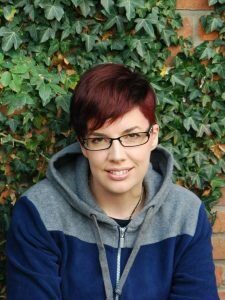Marieke Nijkamp’s This Is Where It Ends reached #1 on the New York Times YA hardcover list in the first week of September, a fantastic achievement for a Dutch-based writer, whose second language was English – equally fantastic when the diverse range of characters in the novel is taken into account.

Author Marieke Nijkamp.
This Is Where It Ends is the gut-wrenching and harrowing tale of a school shooting in Opportunity, Alabama. Told from four diverging points of view, the novel covers 54 minutes where everything changes, and for some, everything ends.
This Is Where It Ends is available now. For more, visit Nijkamp on her website or .
What drove you to write such a diverse cast of characters, and then to explicitly mention what marginalizations they face? Was it something that came along with visualizing and inventing each character, or a deliberate act with a specific purpose?
Honestly, I wanted to write this story as respectful and realistic as possible, and to me that means creating an inclusive story or diversity, so you will. That’s not an agenda or a deliberate act; it’s the real world.
As a queer woman myself, finding characters I identify with in books has not always been easy. Can you speak to why you think it is important to included queer characters in YA?
We’re here. We read books. And we deserve to find ourselves represented.
But more than that, we live in a cisheteronormative world, and we should obviously try to dismantle that. Until we do, for those of us who aren’t cis and/or hetero, it can be a long and difficult process finding yourself. For me, books shaped my understanding of the world. Among thousands of stories, I read maybe a handful that featured disabled characters or queer characters and never both at the same time. With mirrors, I might have understood more, sooner.
With windows, so too might the people around us.
As with queer characters, finding disabled characters in YA is not the easiest task. On a similar vein, did your own identity as a disabled woman play into your decision to write a disabled character? If so, why?
First of all, I’m a reader who is still looking for windows and mirrors. And I write to craft them. So it’s always a conscious decision.
But that’s only a small part of it. Mostly, I write queer and disabled characters because I want to write about the most interesting characters. Because I want to write inclusive stories I believe in. I want to create new story worlds. I want to add to a broader narrative. I want to explore possibilities and untold secrets.
I write queer and disabled characters not just because I love to read them, but because I love to write them.
You live in the Netherlands and wrote about a diverse cast in the United States. In writing This Is Where It Ends, did you encounter any differences between portraying how a queer character would experience marginalization in the US as opposed to the Netherlands? In general, what cultural differences did you encounter writing a queer teen from the US, if any?
I think it’s important to recognize the difference between marginalization at large and individual experiences.
There are big cultural differences and historical differences between our countries, which influence how a queer character would experience marginalization and discrimination at large. And I think that’s important for the context of a character.
For example, in the Netherlands, marginalization based on lack of equal rights is not much of an issue anymore. We legalized same-sex marriage over fifteen years ago. We instituted broad anti-discrimination laws almost 25 years ago. Equal rights are almost unanimously supported.
Were I to portray a queer character in the Netherlands, all of that and more would feed into their characterization and portrayal. But it doesn’t mean universal acceptance is the only narrative for queer teens in the Netherlands.
Likewise, while writing This Is Where It Ends there were a lot of things that fed into the characterization of my two queer leading ladies. From state legislature (and lack of anti-discrimination laws) to religious perspectives to social acceptance and many other factors. But at the same time, that doesn’t mean intolerance is the only narrative for queer teens in Opportunity, Alabama.
Individual experiences and marginalization at large do not always match up. There is no single way to be a queer teen in the Netherlands, just like there is no single way to be a queer teen in the US. There is no single story. Our narrative includes many different voices and many different experiences.
Fill out the form below to win an advanced reader’s copy of This Is Where It Ends when available. Giveaway prizes donated by Sarah Strange. Open to the U.S. only. Void where prohibited.

